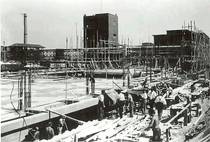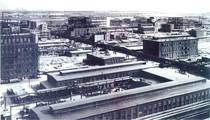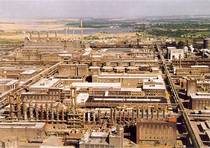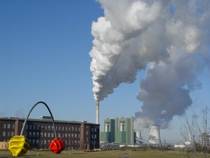
Start of Construction 1936

View of factory 1962

1991

DOW Olefinverbund GmbH
1936 Laying of the foundation stone in April for the worldwide first synthesis India rubber work of the dye industry IG between Halle and Merseburg.
1937 Production beginning as a subsidiary of the ammoniated factory Merseburg under the name Buna-Werke GmbH Schkopau. The classical procedure to the production of India rubber, the Polymerisation of BUtadien with sodium, gaves the name - BUNA
1938 The power station A 65 delivers the first stream and steam. New chemical plants for the production of pre-products originate in rapid succession.
1940 Beginning of the production of polyvinyl chloride (PVC) after the emulsion procedure.
1941 Arrangements to the production of Trichlorethylen, formaldehyde and Tetrahydrofuran go to company.
1943 After a longer rest in the work construction the production is taken up by acetic acid, acetic acid anhydrid and acetone.
1944 The Buna Factory main spared up to the summer, 1944 of direct war effects. Only in November and December air raids cause isolated damages in the work.
1945 At the end of the 2nd world war 10.259 manpower is occupied, under it about 6,000 forced laborers. In July the work will hand over to the Soviet army and a work commander takes over the management.
1946 As a result of the Reparationsleistungen to the USSR which are covered in the essentials by the production the enterprise is converted from August into a Soviet AG.
1948 The rubber production amounts to about 50 percent of the achievement installed in 1937. The systematic research is taken up again and the range of products is extended.
1954 At the end of the year become the Soviet AG rubber to belonging chemical works Buna in GDR property would cross.
1958 Under direction of the GDR government the work to 1960-away is developed. " Plaste and Elaste from Schkopau " becomes during the subsequent years the stamping slogan for the range of products.
1960 The new arrangement to the production of suspension-PVC after a procedure developed in Schkopau takes up the production. With the introduction of the anew established Carbidfabrik becomes of the VEB Chemische Werke Buna with a whole capacity of approx. one million metric tons Calciumcarbid per year of the biggest Carbidproduzent of Europe.
1966 This year made Butadien is used with the production admission by very low-temperature India rubber for the first time of oil.
1970 From the Schkopauer Buna works there originates the combine VEB Chemische Werke Buna.
1976 The rising need in plastics cannot be covered with the available arrangements any more. On the base of a barter system the establishment of an entire production rope is agreed with the company Uhde for the chlorine, VC-and PVC production.
1980 In spring, 1980 the expansion of the factory is concluded to the biggest plastic producer of the GDR with the introduction of a chlorine great arrangement VC/PVC in the essentials. The Kombinat counts with an interest of about 10 percent in the chemical production to the most important enterprises of the GDR.
1985 In the time till 1985 and during the subsequent years several milliard GDR marks is invested in the rationalisation and automation of the production. Single arrangements are equipped with modern electronic controls.
1986 About 200 million Mark is given on environment-relieving measures. The biological-mechanical sewage processing arrangement goes to company.
1987 After the production plant for very low-temperature rubber as a result of a fire precipitates, a new very modern standing was established in only one year.
1988 In June the protection and advancement of the Carbo chemistry is decided by the council of ministers and is confirmed for the time up to 2000.
1989 With the political turn in the GDR all conditions of the enterprise policy change all of a sudden. The fateful decision to the removal of the Carbochemie ends in an energy-political and ecological fiasco.
1990 The Kombinat VEB Chemische Werke Buna is converted into the BUNA AG and is put to 100 percent under the economic management of the trust institution. The climbing out from the unprofitable and very environmental-incriminating Carbid acetylene chemistry and the entire rearrangement to the Ethylenchemie begins.
1991 Beginning the renovation work on the area of the BUNA AG. More than 100 buildings and closed production plants are torn off and dismantled, the beräumten surfaces are prepared for the construction of new arrangements and company settlements.
1992 The in the long term invested renovation and modernisation draught is confirmed by the supervisory board of the BUNA AG. The establishment of a new coal-fired power station is agreed with the VEBA Kraftwerke Ruhr AG.
1993 Test company of the first new production plant for technical plastics. By the investments of the last three years the BUNA AG developed to a profitable and environmental-acceptable chemicals company. In preparation of the privatisation the supervisory board decides the change of the BUNA AG in a Ltd.
1994 The Olefinverbund with his locations in Schkopau, Leuna and Böhlen originates. The restructuring and modernisation leads the way quickly.
1995 Privatisation of the group by the US-American investor The Dow Chemical Company, Midland (Michigan). The joint undertaking is put down under the new Namen Buna Sow Olefinverbund GmbH (BSL) on the commercial register.
1996 Up to 2000 more than 4 milliard DM is invested in the other restructuring of the enterprise BSL. It is planned to establish other chemical plants during the next years.
2000 With his new and developed products the enterprise is an asked trading partner at the market. Dow Chemical produces in modern, ecologically friendly arrangements and has done the Buna work again an internationally competitive chemical location to thanks of the investments in research and development.
2004 Today the work Schkopau as a part of the Dow Olefinverbund GmbH is a competitive and market-oriented chemicals company